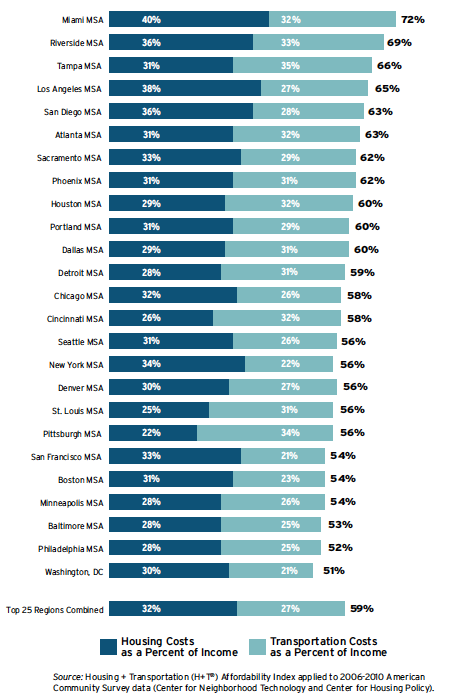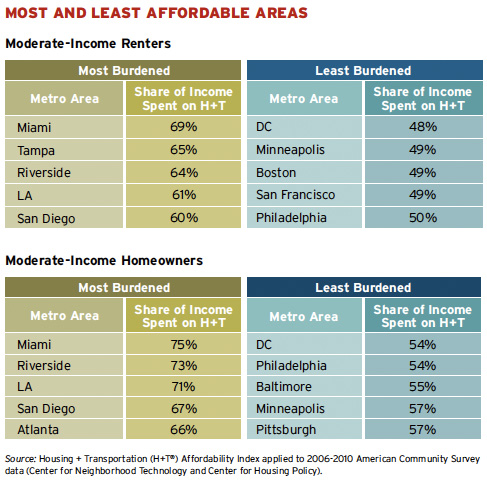So, how did Washington, D.C. -- widely perceived as one of the most expensive cities in the country -- end up topping a “most affordable” housing list?
First and most importantly, adjust for average income levels. Then, factor in transportation costs. Using that formula, the D.C. region is tops among 25 American metro areas in a new study from the Center for Housing Policy and the Center for Neighborhood Technology that looks at the ability of moderate-income households to shoulder the burden of housing and transportation costs [PDF]. The notoriously pricey Boston and San Francisco also make it into the top six.
The joint study came up with some other surprising findings. For example, it turns out it’s more affordable to live in New York City than it is to live in Cincinnati, based on the metrics used. And in general, renters fare better than homeowners in covering their costs of living.
In all 25 cities, middle-class households spent more than half of their incomes on combined housing and transportation costs between 2000 and 2010. Miami had it worst, with housing and transportation eating up 72 percent of the average income.
The study, titled “Losing Ground,” focuses on the disparity between income levels and steadily rising housing and transportation costs. Over the decade, researchers found, for every $1 in income gains, combined housing and transportation costs rose $1.75.
“Losing Ground” follows a 2006 study from the same organizations that took the novel approach of factoring in transportation costs to gauge the affordability of different metro areas. Measuring affordable living by looking strictly at housing costs, without including transportation, "tends to mislead people," said Scott Bernstein, president of the Center for Neighborhood Technology, in a teleconference yesterday. Gathering this information comprehensively, he said, “has profound implications for a set of policy choices.”
Comparing certain cities highlights the need to consider transportation (calculated here as transit fares or the costs of driving and owning car). Take Cincinnati, which ranks in the middle of the pack for affordability despite significantly lower-than-average housing prices. In this study, walkable, transit-rich New York City ranks as more affordable – its low transportation costs, together with strong incomes, help water down the impact of pricey housing.
One key detail: The new study defines “moderate incomes” differently for each metro area, looking at households earning between 50 and 100 percent of that area’s median income. So in Miami, a “moderate income” ranges between $25,444 and $50,888; in D.C., it's $44,531 to $89,063.
In the lowest-ranking cities – after Miami, it’s Riverside, California; then Tampa, Los Angeles and San Diego – incomes simply weren’t high enough to offset the expense of housing and transportation. For example, even though Miami’s housing and transportation costs ranked slightly lower than average, its low incomes inflated the burden of those costs. Robert Hickey of the Center for Housing Policy noted that the area has seen a lot of job loss. "When people lose their jobs or downshift to a part-time job... that doesn’t mean that their housing and transportation costs go down," he said.
In expensive cities like D.C., Boston, and San Francisco, higher incomes helped cushion the shock. In all three cities, housing costs were higher than average – in D.C., transportation prices were also notably higher – yet those costs consumed a lower fraction of total income.
The study made an important change from its 2006 precursor by including homeowners who had paid off their mortgages, as opposed to only those who were in the process of doing so. But either way, renters did better. The typical moderate-income renter spent 55 percent of their income on housing and transportation, compared to 62 percent for both types of homeowners. The report doesn't theorize much on why this is, though one researcher pointed out yesterday that renters are more likely to live in places where they're spending less on housing and, especially, transportation.
Less surprising is the study’s neighborhood-specific data, which found that households located closer to downtown cores and transit lines paid significantly less for housing and transportation combined, compared to those located further out. Transportation made the big difference there. In the D.C. area, "if you try to save money by trying to buy an apparently cheaper house in Virginia, which is not by a Metro line [or train] … you’ll pay for it" in higher costs for car ownership and travel, Bernstein said in an interview yesterday.
The study’s takeaway is “that we must expand affordable housing in places where transportation costs are low,” said Chris Estes, president and CEO of the National Housing Conference. “We really have to intervene in the housing market to make sure folks have the possibility to live there.” Estes advocated for “nonpartisan, long-term solutions” to avoid pushing low- and moderate-income households “to the outskirts” of transit-rich urban centers.
The study itself doesn’t get terribly specific in prescribing policy solutions, but it does suggest that metro areas need to tweak their zoning and regulations – and get creative with financing solutions – to center housing around transit investments. In these “location-efficient” spots, policy makers should work to preserve existing affordable housing and encourage more of it, and to reduce the costs and barriers to land acquisitions and new housing developments. Meanwhile, areas where housing is already affordable need to get more transit-accessible and pedestrian-friendly.
At the federal level, the study points to proposed reforms to the Federal Transit Administration’s “New Starts” program as one way to incentivize both maintaining and developing affordable housing along new and expanded transit lines.







